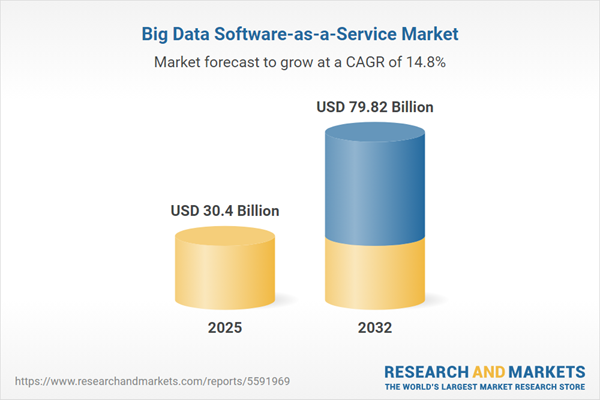Speak directly to the analyst to clarify any post sales queries you may have.
The global Big Data Software-as-a-Service (SaaS) market is undergoing rapid transformation as organizations increasingly rely on cloud-based analytics to strengthen digital strategies and drive competitive differentiation. This executive summary distills actionable insights for decision-makers seeking to navigate this evolving landscape, manage risk, and capture opportunities.
Market Snapshot: Big Data SaaS Growth and Outlook
The Big Data Software-as-a-Service market grew from USD 26.40 billion in 2024 to USD 30.40 billion in 2025. It is projected to experience continued momentum with a CAGR of 14.83%, reaching USD 79.82 billion by 2032. Sustained investment in cloud-native analytics and the evolving needs of global enterprises are propelling sector expansion amid rising demand for flexible, scalable, and secure data solutions.
Scope & Segmentation
- Component: Services (Professional Services, Support and Maintenance), Software
- Organization Size: Large Enterprises, Small and Medium Enterprises
- Deployment Model: Hybrid Cloud, Private Cloud, Public Cloud
- Application: Data Analytics, Data Integration, Data Management, Data Security, Data Visualization
- Industry Vertical: BFSI (Banking, Capital Markets, Insurance), Energy and Utilities, Government, Healthcare (Healthcare Payers, Hospitals and Clinics, Pharma and Biotech), Manufacturing (Automotive, Discrete, Process), Retail (E Commerce, Hypermarket and Supermarket, Specialty Stores), Telecom
- Region: Americas (United States, Canada, Mexico, Brazil, Argentina, Chile, Colombia, Peru), Europe, Middle East & Africa (United Kingdom, Germany, France, Russia, Italy, Spain, Netherlands, Sweden, Poland, Switzerland, United Arab Emirates, Saudi Arabia, Qatar, Turkey, Israel, South Africa, Nigeria, Egypt, Kenya), Asia-Pacific (China, India, Japan, Australia, South Korea, Indonesia, Thailand, Malaysia, Singapore, Taiwan)
- Key Players: Amazon Web Services, Inc., Microsoft Corporation, Google LLC, Oracle Corporation, International Business Machines Corporation, SAP SE, Snowflake Inc., Splunk Inc., Databricks, Inc., Cloudera, Inc.
Key Takeaways for Big Data SaaS Decision-Makers
- Cloud-native Big Data SaaS solutions streamline data infrastructure, enabling organizations to reduce operational complexity and accelerate business insight cycles.
- Advanced analytics offerings, such as machine learning and predictive modeling, are integrated directly within platforms, supporting more proactive, data-driven strategies.
- Democratization of analytics is increasing business user engagement across departments, fostering collaboration and improving the quality of decision-making.
- Hybrid cloud approaches are rising, blending flexibility and scalability with compliance, particularly relevant in sectors requiring strict data control.
- Industry-specific solutions, such as those tailored for financial services, healthcare, and manufacturing, are refining adoption paths and supporting regulatory alignment.
- Regional markets display divergent drivers and barriers; regulatory requirements, infrastructure readiness, and digital maturity shape local implementations.
Tariff Impact: U.S. 2025 Policy and Supply Chain Adaptation
The introduction of United States tariffs in 2025 has influenced hardware sourcing and operating costs for global Big Data SaaS providers. Vendors have responded by adjusting subscription models and accelerating the deployment of regional data centers. These strategic actions help preserve competitive pricing and maintain compliance with evolving data sovereignty standards. Technology partners increasingly diversify supply chains and explore alternative infrastructure arrangements to ensure business continuity and mitigate risk exposure.
Methodology & Data Sources
This report is based on a robust methodology that blends primary interviews with IT and SaaS leaders, insights from regulatory experts, and analysis of industry publications. Qualitative and quantitative approaches identify market trends, segmentation nuances, and regional variances, while validation steps assure data reliability and actionable intelligence.
Why This Report Matters for Senior Leaders
- Clarifies emerging trends and best practices for Big Data SaaS adoption, supporting effective digital transformation strategies at scale.
- Highlights actionable segment, technology, and regional dynamics, enabling organizations to benchmark practices and compete effectively.
- Informs supply chain decisions and risk mitigation initiatives in light of shifting regulatory and policy requirements.
Conclusion
Senior decision-makers seeking to drive value from Big Data SaaS solutions will benefit from strategic adoption, strong governance, and adaptive frameworks. This report sheds light on core dynamics, empowering leaders to make informed investment and operational choices in a fast-changing environment.
Additional Product Information:
- Purchase of this report includes 1 year online access with quarterly updates.
- This report can be updated on request. Please contact our Customer Experience team using the Ask a Question widget on our website.
Table of Contents
3. Executive Summary
4. Market Overview
7. Cumulative Impact of Artificial Intelligence 2025
Companies Mentioned
The companies profiled in this Big Data Software-as-a-Service market report include:- Amazon Web Services, Inc.
- Microsoft Corporation
- Google LLC
- Oracle Corporation
- International Business Machines Corporation
- SAP SE
- Snowflake Inc.
- Splunk Inc.
- Databricks, Inc.
- Cloudera, Inc.
Table Information
| Report Attribute | Details |
|---|---|
| No. of Pages | 185 |
| Published | November 2025 |
| Forecast Period | 2025 - 2032 |
| Estimated Market Value ( USD | $ 30.4 Billion |
| Forecasted Market Value ( USD | $ 79.82 Billion |
| Compound Annual Growth Rate | 14.8% |
| Regions Covered | Global |
| No. of Companies Mentioned | 11 |









